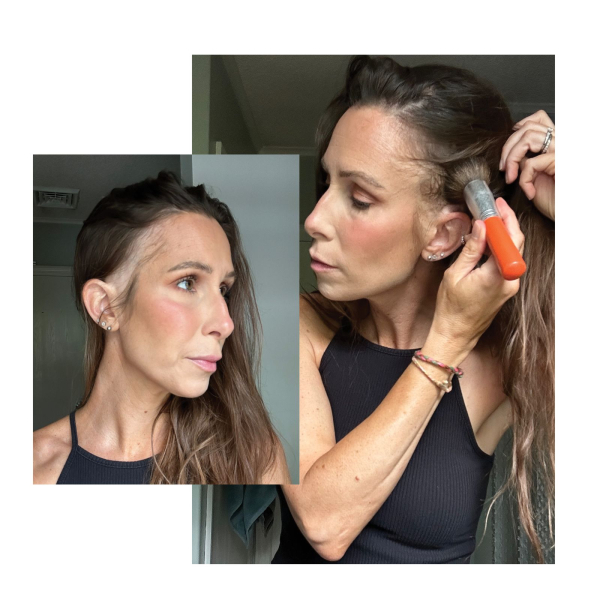 Illustration by Briana Rengifo/Allure; Source images: Getty ImagesSave this storySave this story
Illustration by Briana Rengifo/Allure; Source images: Getty ImagesSave this storySave this story
All products featured on Allure are independently selected by our editors. However, we may receive compensation from retailers and/or from purchases of products through these links.
When she noticed she was missing a horizontal strip of hair above her ears, Jayme Cawthern assumed she’d accidentally yanked out a chunk of it while styling. Only when the same hair loss pattern showed up on the other side did the 41-year-old graphic designer from Pennsylvania start to worry. Her primary care doctor told her to keep an eye on it, but the missing patches of hair kept getting bigger. In October 2021, five months after Cawthern noticed the first bald patch, a dermatologist diagnosed her with a type of hair loss called frontal fibrosing alopecia (FFA).
Compared to other forms of hair loss, FFA is a relatively new diagnosis. Since it was first named in medical literature in 1994, cases continue to rise, especially among post-menopausal women a decade or more older than Cawthern. In 2018, researchers surveyed medical literature and found the number of publications referencing FFA increased from just one in 1994 to 44 in 2016—an uptick they called an “emerging epidemic.”
Dermatologists say they’re seeing more and more cases. “I wouldn’t call it common, but we see it much more commonly than we did before,” says Paradi Mirmirani, a board-certified dermatologist with Kaiser Permanente in Vallejo, California, and lead author of the 2018 research. Viktoryia Kazlouskaya, a board-certified dermatologist at Dermatology Circle in New York City, says she rarely saw the condition during her residency 20 years ago. “Now, I have to handle it nearly daily,” she tells Allure.
In the five years since Jayme Cawthern was diagnosed with frontal fibrosing alopecia, she has lost much of the hair along the sides of her hairline. One of the ways she conceals it is by applying a root touch-up spray with a big makeup brush. Courtesy of Jayme Cawthern.
While FFA isn’t reversible—once you lose the hair, it’s gone for good—medical treatment can slow it down and control uncomfortable symptoms. Below, learn more about this increasingly common kind of hair loss, and how dermatologists can help you minimize its progress.
Meet the experts:
- Paradi Mirmirani, MD, is a board-certified dermatologist with Kaiser Permanente in Vallejo, California.
- Lindsey Bordone, MD, is a board-certified dermatologist at Columbia Medicine in New York City.
- Corey L. Hartman, MD, is a board-certified dermatologist and founder of Skin Wellness Dermatology in Birmingham, Alabama.
- Jeffrey Fromowitz, MD, is a board-certified dermatologist at Dermatology of Boca in Boca Raton, Florida.
- Viktoryia Kazlouskaya, MD, is a board-certified dermatologist at Dermatology Circle in New York City.
What are the symptoms of frontal fibrosing alopecia?
As Cawthern experienced, the hallmark symptom of FFA is a receding hairline. “People describe their hairline going back and losing their widow’s peak, or losing hair along the sides of the hairline, or even the back of the scalp,” says Dr. Mirmirani.
Before the hairline starts to change, people with FFA often lose hair in their eyebrows. “It usually happens on the lateral end of each brow, by the temples,” says board-certified dermatologist Corey L. Hartman, founder of Skin Wellness Dermatology in Birmingham, Alabama. “The eyebrow hair just falls out and doesn’t come back.” That’s what happened to 47-year-old Laura*. “I started noticing my eyebrows thinning almost two years ago, but didn’t think that much of it,” she says. “Then I went to a dermatologist to have a mole looked at, and she said she wanted to investigate the eyebrow situation.” That doctor did a scalp biopsy, stamping out a circle of skin about the size of an eraser tip, and the results indicated FFA. (While some doctors diagnose FFA based on a patient’s history, symptoms, and an exam, many use a biopsy to confirm the diagnosis.)
So far, Laura hasn’t lost any hair on her scalp, but all the doctors I spoke with said that, in their experience with FFA, hair on the head almost always starts to fall out eventually without treatment. It’s a process, Dr. Hartman says can happen quickly or take years to progress (even without treatment).
While some people only lose hair with FFA, the condition can also cause physical discomfort due to the inflammation of the hair follicles—about 25% of people with FFA report pain and itching. “It felt like microscopic bugs were moving underneath the surface of my scalp,” says Marilyn Ey, 75, from Dallas, who was diagnosed with FFA in 2007, after starting menopause in the mid-1990s.
Other people with FFA experience hair follicle inflammation without any actual hair loss. “I have FFA patients whose hairlines are beet red,” says Lindsey Bordone, a board-certified dermatologist at Columbia Medicine in New York City. “Their hairlines haven’t budged at all, but they’re chronically inflamed.” If that inflammation is left untreated, FFA will always progress to hair loss, says Dr. Mirmirani.
When hair loss does occur, recession can progress to mid-scalp—both Cawthern and Ey say their hairlines have receded about four inches. Once the hair falls out, people often develop waxy, white, shiny dots of scar tissue over the follicles, indicating the hair follicle is dead and won’t recover, according to board-certified dermatologist Jeffrey Fromowitz, founder of Dermatology of Boca in Boca Raton, Florida.
Along with physical symptoms, FFA can take a major toll on the quality of life and mental health. “The way we present to the world is the skin of our face, our hair, and our eyebrows. So whenever we suffer loss or issues with those areas, the psychological and emotional impact is tremendous,” says Dr. Fromowitz.
And it’s often difficult for FFA patients to hide their hair loss due to its location (for example, you could more easily conceal hair loss on the crown with a hairpiece). Often coming at the same time as other age-related changes, the condition can be especially hard. “Turning 40 was hard for me with face changes, wrinkles, and droopiness. The combination of those with the hair loss has been intense,” says Cawthern.
What causes frontal fibrosing alopecia?
Some degree of hair loss is normal. Every day, you can shed up to 100 strands of hair, but most people don’t notice because other hair is actively growing in at the same time. Alopecia, the medical term for hair loss, happens when something stops the hair from growing, resulting in noticeable thinning or bald spots.
Female pattern hair loss (FPHL), or androgenetic alopecia, is by far the most common type of hair loss in women, causing thinning on the top and sides of the head. Over 40% of women notice some FPHL by age 50. Alopecia areata, a form of hair loss that causes bald patches, affects about 700,000 Americans of all ages and genders but is more likely to develop in women, according to the National Alopecia Areata Foundation.
FFA is much rarer than alopecia areata and is a type of scarring alopecia, which means that when hair falls out, scar tissue forms over the dead follicle. Like alopecia areata, it’s considered an autoimmune disease because the immune system is destroying hair follicles. As with other autoimmune conditions, experts aren’t completely sure why the immune system gets triggered into overdrive and attacks hair follicles.
Marilyn Ey was diagnosed with FFA in 2007, after starting menopause in the mid-1990s. Courtesy of Marilyn Ey.
Genetics may be one reason, but given the prevalence of FFA among women whose periods have stopped, researchers theorize shifting hormones could be part of the issue. “We know that hair follicles are estrogen-sensitive because there are estrogen receptors on them,” says Dr. Mirmirani. “So when estrogen fluctuates, there’s probably some effect on the hair follicle.” (That’s also why menopause can cause hair thinning and graying, explains Dr. Kazlouskaya.)
Exposure to environmental pollutants, Dr. Kazlouskaya adds, could also be a factor. So could cosmetics and hair products. Some studies have found microparticles of zinc in the hair follicles of FFA patients, suggesting that sunscreen could be part of the onset. The operative word is could. And no, that’s not a sign to stop using SPF. “We put a lot of things on our skin, more than people in previous generations,” says Dr. Mirmirani. “The skin may absorb things that aren’t helpful to the hair follicle and disrupt the immune system.” In general, Dr. Mirmirani says she doesn’t recommend sunscreen changes for patients who don’t have FFA. For those with FFA, she usually suggests mineral sunscreens with larger zinc particles that don’t easily penetrate the epidermis, as formulas with nanoparticles can. Tinted sunscreen, which also has larger mineral particles, is another option.
Ultimately, researchers aren’t totally sure what’s behind the rising numbers of patients with FFA. It could be the reduced estrogen levels of perimenopause and menopause. It may involve increased exposure to chemicals and other pollutants. It could also be that dermatologists are simply more familiar with the condition, so they’re diagnosing it more. “There’s more awareness and pictures on the internet, so more of us are recognizing it,” says Dr. Bordone.
What are the treatments for frontal fibrosing alopecia?
The goal of all FFA treatments is to slow the progress of hair loss while controlling any pain and discomfort. “You want to treat it as quickly as possible because once the follicle is destroyed, it can’t be regained,” says Dr. Hartman.
Treatments vary depending on the severity and symptoms. As a first step, Dr. Mirmirani always recommends that FFA patients stop using harsh or scented skin-care and hair-care products to prevent unnecessary irritation and inflammation. “We want to remove anything on the skin or scalp that may be adding fuel to the fire or contributing to inflammation,” she says.
If someone has redness and inflammation, a dermatologist may recommend anti-inflammatory drugs. Steroid injections into the scalp can help reduce redness and pain, but Dr. Bordone says they can cause atrophy, or visible dents near the hairline. “I had a sunken look on my forehead,” says Ey, who had steroid injections go wrong after she was first diagnosed with FFA. To reduce the risk of side effects, Dr. Bordone prefers to prescribe topical steroid drops to address symptoms. Dr. Mirmirani says the length of time patients stay on steroids usually depends on the strength, with stronger steroids generally taken for just a few weeks. Over-the-counter steroid options, like topical hydrocortisone, can be used on the brows. Dr. Mirmirani says some doctors also recommend the prescription lash growth serum Latisse off-label for eyebrows. Systemic drugs, including the antibiotic doxycycline, can help cool off inflammation in the scalp during flare-ups and can be used for one month to a year.
Cawthern has found many ways to conceal the changes in her hairline, from clip-in bangs to headbands. In an effort to help other women dealing with hair loss, she shares them all on her Instagram @jayme.eileen. Courtesy of Jayme Cawthern.
Some drugs help slow the progress of hair loss. An oral version of minoxidil (which you might know as the active ingredient in Rogaine) can be prescribed to help “preserve hair follicles that might be weakened from inflammation,” Dr. Bordone says. “It dilates blood vessels so you can rescue the follicle.” Dutasteride, an oral medication commonly used to treat an enlarged prostate, can also help protect hair follicles by blocking chemicals that can contribute to hair loss. Dr. Mirmirani says studies have shown that dutasteride is a better option for FFA than finasteride (known as Propecia), a shorter-acting version of a similar drug. But if a patient is still getting a period, she prefers finasteride because it’s less likely to cause problems in the case of an unexpected pregnancy.
One medication that might one day prove useful for FFA is metformin, a drug that has FDA approval to treat high blood sugar in people with type 2 diabetes. It's emerged as a potential treatment for central centrifugal cicatricial alopecia (CCCA), another type of scarring alopecia, this one seen most commonly in Black women. According to Dr. Mirmirani, there isn't really any data yet for the off-label use of metformin to treat FFA, “but there are some case reports of off-label use for CCCA.” One of them was published by Crystal Aguh, MD, a board-certified dermatologist, associate professor of dermatology, and director of the Ethnic Skin Program at the Johns Hopkins School of Medicine, who recently spoke with Allure about the latest treatments for CCCA. Based on the existing, albeit limited, research as well as her own clinical experience, board-certified dermatologist Oyetewa Asempa, MD, told us, “We now believe that metformin may have a chance at reversing some of the scarring seen in hair loss in certain patients.”
Medications that suppress the immune system may help treat FFA, but like all immunosuppressants, they can cause an increased risk of infection and illness. Cawthern presently takes the immunosuppressive drug hydroxychloroquine, and she says it helped slow down her hair loss. Recent research suggests JAK inhibitors, drugs approved to treat autoimmune conditions like rheumatoid arthritis and ulcerative colitis, may help stop the immune system from attacking hair follicles. Since FFA could be linked to the fluctuating hormones of the menopause transition, it stands to reason that hormone replacement therapy (HRT) may also be helpful. So far, however, there's no evidence that that’s the case. “Early studies on FFA looked at treatment with HRT, but it didn’t seem to provide any benefit,” says Dr. Mirmirani.
Even with effective treatment, hair loss usually progresses, forcing FFA patients to get creative with styling and rebuild their confidence in the process. Cawthern has tried hair extensions and hair toppers, but she most often uses root touch-up spray to camouflage the missing hair on the sides (she’s a fan of Tresemmé's, in dark brown). Still, she feels self-conscious about her appearance, especially when she’s getting ready for special occasions. Ey strategically combs and uses hairspray on her bangs to hide her hair loss. Laura has tried a wide array of brow pencils to restore her lost arches, and found that Patrick Ta’s is by far the most natural against her black hair and olive skin. She says she got some of her best tips on application and blending from this Allure video with a model who has alopecia areata.
Looking back, Cawthern says she would have sought out a dermatologist when she first noticed symptoms, but she hadn’t heard of FFA, so she didn’t know what to look for. Experts agree that treatment is most effective when it is caught early, so if you believe you have symptoms of FFA or any type of hair loss, check with a board-certified dermatologist ASAP. “I wish I had gone when I had the little stripe on my scalp,” Cawthern says. “If that was all the loss I had, I would be so ecstatic.”
* Name has been changed for privacy.






